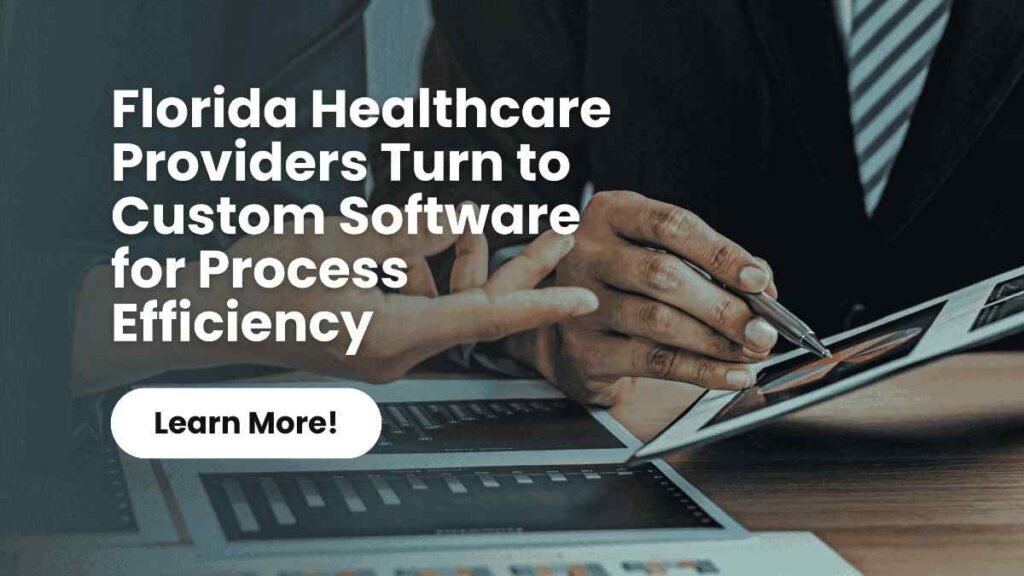It’s 9:02 AM at a bustling outpatient clinic in Orlando. The front desk is already fielding calls, checking patients in, scanning insurance cards. In one exam room, a physician toggles between four tabs on an aging EHR system, trying to pull up patient history, while a nurse in another wing manually updates a whiteboard with room assignments.
For many in Florida’s healthcare system, this scene is uncomfortably familiar—and increasingly untenable.
Behind the white coats and digital clipboards lies a truth the industry has tried to bandage for too long: the very software meant to streamline care often gets in the way of delivering it.
That’s changing—and quickly. A quiet but decisive shift is underway. Healthcare providers across Florida, from Miami to Jacksonville, are embracing custom software development not just as a tech upgrade, but as a strategic necessity. They’re doing it to survive. To scale. And above all, to serve better.
The Problem with “One Size Fits All” in Healthcare
Healthcare is anything but standard. Regulations change by state. Patient populations vary by region. Workflows differ across specialties, and even among departments within the same hospital.
Yet for years, providers were expected to operate under a patchwork of inflexible systems—generic EHRs, third-party scheduling tools, outdated billing platforms—all duct-taped together in the name of compliance.
It worked. Barely.
The result? Frustrated staff, costly redundancies, and countless hours lost to navigating software instead of treating patients.
Custom software isn’t about bells and whistles. It’s about addressing the messy, real-world complexities of healthcare. It’s about fitting the tool to the practice, not the other way around.
Streamlining Clinical Workflows
Let’s get to the heart of it: clinical efficiency saves lives. But in many Florida practices, inefficiencies are deeply embedded in the system.
Take patient intake, for example. A standard visit can involve:
-
Manually entering forms from paper
-
Verifying insurance against multiple portals
-
Tracking down missing lab results via fax
-
Transferring data between incompatible systems
Custom software helps collapse these steps into a seamless flow. Imagine an intake system tailored to your specialty—say, pediatric neurology—that captures relevant details upfront, integrates with your EHR, checks insurance eligibility in real-time, and routes patients to the right specialist—all without redundant data entry.
In Miami-Dade, one urgent care network cut average intake time by 35% using a custom-built application that pulled patient data directly from local health exchanges and synced with their internal triage system.
That’s not just convenience. That’s operational precision—and it changes the pace of care.
Smarter Scheduling, Fewer No-Shows
In healthcare, time is everything. A missed appointment isn’t just lost revenue—it can delay treatment, clog schedules, and ripple through a day’s operations.
Off-the-shelf scheduling platforms often lack the nuance to manage specialty clinics, rotating physician shifts, or patient-specific prep time. They’re made for predictability. Healthcare is anything but predictable.
Custom scheduling software can:
-
Auto-adjust based on provider availability, location, or even equipment needed
-
Trigger SMS/email reminders based on patient preferences
-
Offer self-service portals with real-time slot visibility
-
Flag high-risk no-show patients for proactive follow-up
A cardiology group in Tampa integrated predictive analytics into their custom scheduler. It identified patients with a history of missed visits and automatically double-confirmed appointments via text. No-show rates dropped by 28% within two months.
Now that’s the kind of backend intelligence healthcare needs—and patients appreciate.
Billing and Claims: From Black Box to Transparent Engine
Ask any Florida healthcare administrator what keeps them up at night, and billing is likely in the top three. Medical billing is notoriously complex, with layers of codes, ever-changing payer rules, and rejection rates that could make a CFO cry.
Custom software doesn’t just automate—it clarifies. A purpose-built billing engine can:
-
Embed updated CPT/ICD codes and payer-specific logic
-
Flag potential errors before submission
-
Streamline appeals with built-in templates and audit trails
-
Connect to clearinghouses in real-time
-
Give patients clearer bills (yes, it’s possible)
One orthopedic practice in Sarasota reported recovering over $100,000 in previously lost revenue after switching to a custom claims management platform that caught recurring denial patterns in pre-authorization.
When you have tools built specifically for your reimbursement landscape, billing stops being a bottleneck—and starts being a strategic advantage.
Connecting the Care Continuum
Florida has one of the largest populations of elderly residents in the U.S., which means care coordination is critical. Many patients see multiple providers, juggle chronic conditions, and move between primary care, specialists, home health, and hospitals.
And yet, their data rarely moves with them.
Custom integration software can stitch together disparate systems—EMRs, labs, imaging centers, pharmacies—into one unified dashboard. Care teams can track everything from medication adherence to recent hospitalizations without jumping through digital hoops.
A home health agency in Palm Beach County used a custom-built interoperability solution to sync with local hospitals. Now, when a patient is discharged, the agency receives real-time updates and can schedule follow-up visits within hours, not days.
That’s what modern care continuity looks like. And it’s powered by software that understands the terrain.
Regulatory Compliance, Built-In from Day One
HIPAA isn’t optional. Nor are Florida’s stringent patient data laws or CMS reporting standards.
But compliance isn’t something you slap on at the end of a development cycle. It needs to be baked into the architecture.
Custom healthcare software is designed with privacy in its DNA:
-
Role-based access control ensures users only see what they need
-
Audit logs track every interaction
-
Encryption protects data in transit and at rest
-
Consent management tools respect patient choices and records
With custom solutions, you’re not just avoiding penalties—you’re building patient trust and legal resilience. And in an age of growing cyber threats, that trust is everything.
Empowering Patients with Self-Service Tools
The modern patient doesn’t want to call a front desk to ask about lab results. They want access. They want clarity. And they want control.
Custom patient portals and apps are giving Florida’s providers a new way to engage, inform, and empower:
-
Secure messaging with providers
-
Digital intake forms and medical histories
-
Prescription refill requests and appointment rescheduling
-
Bill payment and insurance tracking
-
Personalized health education based on condition or treatment plan
It’s not just about convenience. When patients are engaged, outcomes improve. And when engagement is easy—when the software makes it seamless—it becomes second nature.
Telehealth That Actually Works
Telehealth saw a massive spike during the pandemic, and while usage has stabilized, the genie is out of the bottle. Patients now expect virtual options—especially in rural areas or during post-op recovery.
But not all video platforms are created equal. Many clinics in Florida are ditching third-party telehealth apps in favor of custom-built systems that:
-
Integrate directly with patient records
-
Offer real-time charting tools for providers during sessions
-
Support file sharing, e-prescribing, and diagnostics
-
Comply fully with HIPAA, even across state lines
A behavioral health clinic in Tallahassee developed its own telehealth platform that includes virtual group therapy, patient journaling, and therapist dashboards. Their patient engagement doubled within six months—and provider burnout went down, too.
That’s what happens when the platform fits the practice, not vice versa.
Data Analytics: From Reporting to Real-Time Intelligence
Healthcare runs on data. But too often, that data is locked in PDFs, buried in spreadsheets, or siloed across departments.
Custom software flips the script.
By integrating analytics into day-to-day workflows, providers can:
-
Monitor KPIs like readmission rates, treatment adherence, and staff productivity
-
Predict high-risk patients based on historical data
-
Visualize care gaps and intervene early
-
Optimize resource allocation, from supplies to staffing
In Clearwater, a network of family practices used a custom analytics dashboard to reduce ER referrals by 18% by flagging early signs of complications and scheduling urgent visits instead.
Data is power—when you can actually use it.
Collaboration Between Developers and Healthcare Professionals
Here’s a truth the industry doesn’t talk about enough: great healthcare software isn’t built in isolation. It’s the result of constant, close collaboration between tech teams and clinical experts.
The best custom development projects start with deep discovery:
-
Shadowing clinical workflows
-
Interviewing frontline staff
-
Mapping pain points, not just features
-
Testing iteratively in live environments
This partnership model creates tools that not only work but fit. They align with actual needs, real schedules, and the non-negotiable reality of caring for human lives.
And unlike packaged solutions, custom software evolves with your practice. Need to add a new department? Change workflows? Adjust to new regulations? Custom tools flex—because they were built with change in mind.
Cost Considerations and ROI
Let’s address the elephant in the room: custom software isn’t cheap.
But neither is inefficiency. Or revenue leakage. Or staff burnout. Or patient churn.
When done right, custom software is an investment that pays for itself many times over:
-
Reduced operational overhead
-
Faster revenue cycles
-
Better patient retention and satisfaction
-
Lower risk exposure
-
Enhanced staff productivity
A mid-size clinic group in Naples invested in a custom EHR and workflow suite. Initial costs were significant. But in year two, they saw a 22% rise in net revenue, cut administrative hours by 30%, and reduced claim denials by half.
Custom doesn’t mean expensive. It means value—measured by impact, not just invoices.
Conclusion: Custom Software as a Strategic Imperative
Florida’s healthcare providers aren’t just modernizing—they’re future-proofing. The ones leading the way aren’t relying on generic platforms or waiting for updates. They’re building the tools they need, with the partners they trust.
Custom healthcare software isn’t about bells, whistles, or buzzwords. It’s about alignment. Fit. Function. And above all, impact.
As care becomes more connected, more digital, and more demanding, the systems behind it must rise to meet the moment. That means software that doesn’t just work—but works for you.
To make that happen, partner with a software development company in florida that understands healthcare’s unique challenges and is committed to building not just solutions—but better care experiences.
Because in medicine, efficiency isn’t just a metric. It’s a mission. And the right software can help you fulfill it—every patient, every time.
- Custom Software Boosts Efficiency for Florida Healthcare
- Florida healthcare providers adopt custom software to streamline processes, improve patient care, and enhance operational efficiency across the board.
- software development company in florida
Related posts:
 Top 5 Custom Software Development Companies in Edmonton 2025
Top 5 Custom Software Development Companies in Edmonton 2025
 Best ReactJS Development Companies for Scalable Web Apps in 2025
Best ReactJS Development Companies for Scalable Web Apps in 2025
 Find the Best Grocery Delivery App Development Company for Startups
Find the Best Grocery Delivery App Development Company for Startups
 Journeyman Electrician 101: What it is, What they do, and how much they make
Journeyman Electrician 101: What it is, What they do, and how much they make
 Contrast Mapping for Dark Mode Accessibility in Taxi Booking Apps
Contrast Mapping for Dark Mode Accessibility in Taxi Booking Apps
 Boost Your Business with These App Development Companies in Kuwait
Boost Your Business with These App Development Companies in Kuwait
 How to Block Someone on TikTok: A Simple Guide That Works in 2025!
How to Block Someone on TikTok: A Simple Guide That Works in 2025!
 Why Technical Feasibility Studies Save Millions in Tech Development
Why Technical Feasibility Studies Save Millions in Tech Development







